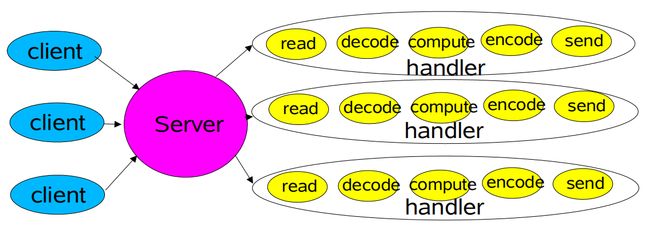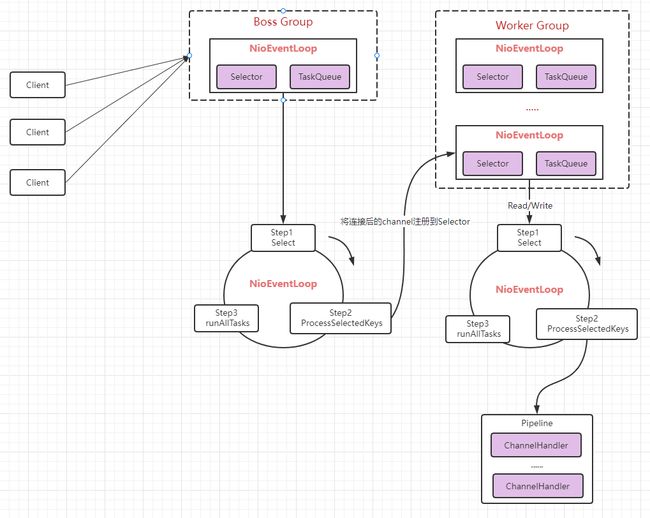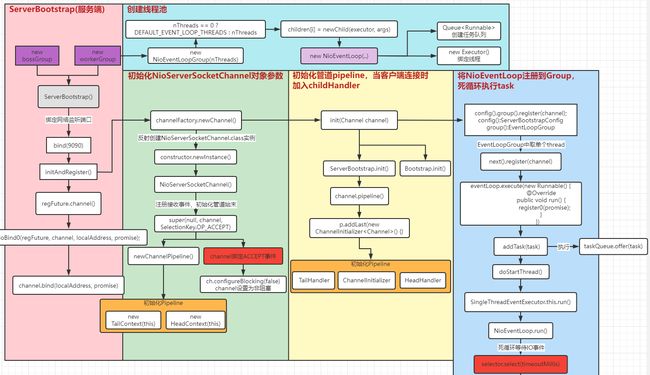网络编程-Netty-02 Netty核心功能及线程模型
文章目录
-
-
- 1、Netty解决的痛点
- 2、Netty的使用场景
- 3、客户端、服务端demo
- 4、Netty线程模型理解
-
- 4.1Doug lea《Scalable IO in Java》中的可扩展的网络IO线程模型
- 4.2 Netty的线程模型(网络版)
- 5、Netty模块组件
-
- 5.1 Bootstrap、ServerBootstrap
- 5.2 NioEventLoopGroup
- 5.2 NioEventLoop
- 5.3 Channel
- 5.4 ChannelHandler
- 5.5 Future、ChannelFuture
- 6、Netty服务端源码流程
- 7、Netty实现聊天室功能
-
1、Netty解决的痛点
- NIO的类库和API复杂,需要对Selector、ServerSocketChannel、SocketChannel、ByteBuffer等做操作。
- 针对客户端断线重连、网络闪断、线条处理、半包读写、网络拥塞、异常等分别处理。
- Netty对JDK自带的API做了封装,能够解决上述问题。
- Netty拥有高性能、高吞吐、低时延等优点。
2、Netty的使用场景
- 分布式系统中,各节点间远程服务调用需要高性能的RPC框架。Netty作为优秀的异步高性能通信框架,往往作为基础通信组件。
- 阿里分布式框架Dobbo进行节点通信,使用Netty进行进程间通信。
- RocketMQ使用Netty作为基础通信组件
- 华为分布式服务框架servicecomb的Edge Service的是基于Netty的vertx作为基础通信组件
- 游戏行业,通过Netty作为高性能基础通信组件,提供TCP/UDP和http协议栈
- 大数据领域,hadoop高性能通信和序列化Avro的RPC框架,默认采用Netty进行跨界点通信。
3、客户端、服务端demo
先跑demo后,了解基本功能,后看源码。
<dependency>
<groupId>io.nettygroupId>
<artifactId>netty-allartifactId>
<version>4.1.73.Finalversion>
dependency>
客户端:
import io.netty.bootstrap.Bootstrap;
import io.netty.channel.ChannelFuture;
import io.netty.channel.ChannelInitializer;
import io.netty.channel.nio.NioEventLoopGroup;
import io.netty.channel.socket.SocketChannel;
import io.netty.channel.socket.nio.NioSocketChannel;
public class NettyClient {
public static void main(String[] args) throws InterruptedException {
//客户端事件循环组 默认线程数为 cpu-core*2
NioEventLoopGroup group = new NioEventLoopGroup(1);
try {
Bootstrap bootstrap = new Bootstrap();
//设置bootstrap参数
bootstrap.group(group)
.channel(NioSocketChannel.class)
.handler(new ChannelInitializer<SocketChannel>() {
@Override
protected void initChannel(SocketChannel ch) throws Exception {
ch.pipeline().addLast(new NettyClientHandler());
}
});
System.out.println("netty client start...");
ChannelFuture cf = bootstrap.connect("127.0.0.1", 9090);
//启动客户端连接服务器
cf.channel().closeFuture().sync();
}finally {
group.shutdownGracefully();
}
}
}
import io.netty.buffer.ByteBuf;
import io.netty.buffer.Unpooled;
import io.netty.channel.ChannelHandlerContext;
import io.netty.channel.ChannelInboundHandlerAdapter;
import io.netty.util.CharsetUtil;
public class NettyClientHandler extends ChannelInboundHandlerAdapter {
/**
* 建连完成
*
* @param ctx
* @throws Exception
*/
@Override
public void channelActive(ChannelHandlerContext ctx) throws Exception {
ByteBuf buf = Unpooled.copiedBuffer("HelloServer".getBytes(CharsetUtil.UTF_8));
ctx.writeAndFlush(buf);
}
@Override
public void channelRead(ChannelHandlerContext ctx, Object msg) throws Exception {
ByteBuf buf = (ByteBuf) msg;
System.out.println("收到服务端的消息:" + buf.toString(CharsetUtil.UTF_8));
}
@Override
public void channelReadComplete(ChannelHandlerContext ctx) throws Exception {
System.out.println("数据流读取完毕");
}
@Override
public void exceptionCaught(ChannelHandlerContext ctx, Throwable cause) throws Exception {
System.out.println("捕获异常"+cause);
}
}
服务端:
import io.netty.bootstrap.ServerBootstrap;
import io.netty.channel.ChannelFuture;
import io.netty.channel.ChannelInitializer;
import io.netty.channel.ChannelOption;
import io.netty.channel.EventLoopGroup;
import io.netty.channel.nio.NioEventLoopGroup;
import io.netty.channel.socket.SocketChannel;
import io.netty.channel.socket.nio.NioServerSocketChannel;
public class NettyServer {
public static void main(String[] args) throws InterruptedException {
//创建管理连接的线程组
EventLoopGroup bossGroup = new NioEventLoopGroup(2);
//创建处理业务逻辑的线程组
EventLoopGroup workerGroup = new NioEventLoopGroup(10);
try {
//创建服务器端的启动对象
ServerBootstrap bootstrap = new ServerBootstrap();
//配置启动参数(两个线程组)
bootstrap.group(bossGroup,workerGroup)
//服务器通道的实现
.channel(NioServerSocketChannel.class)
//将瞬时无法处理的请求加入队列
.option(ChannelOption.SO_BACKLOG,1024)
.childHandler(new ChannelInitializer<SocketChannel>() {
@Override
protected void initChannel(SocketChannel ch) throws Exception {
ch.pipeline().addLast(new NettyServerHandler());
}
});
System.out.println("netty server start...");
//启动服务器(绑定端口号) bind是异步操作 sync是等待异步绑定结果的同步操作
ChannelFuture cf = bootstrap.bind(9090).sync();
//等待服务器监听端口关闭,closeFuture是异步操作
//通过sync同步等待通道关闭处理完毕,这里会阻塞等待通道关闭完成,内部调用的是Object.wait()方法
cf.channel().closeFuture().sync();
}finally {
bossGroup.shutdownGracefully();
workerGroup.shutdownGracefully();
}
}
}
import io.netty.buffer.ByteBuf;
import io.netty.buffer.Unpooled;
import io.netty.channel.ChannelHandlerContext;
import io.netty.channel.ChannelInboundHandlerAdapter;
import io.netty.util.CharsetUtil;
public class NettyServerHandler extends ChannelInboundHandlerAdapter {
/**
* 当客户端与服务端完成连接时出发
*
* @param ctx
* @throws Exception
*/
@Override
public void channelActive(ChannelHandlerContext ctx) throws Exception {
System.out.println("客户端连接通道建立完成");
}
/**
* 读取客户端发送的数据
*
* @param ctx
* @param msg
* @throws Exception
*/
@Override
public void channelRead(ChannelHandlerContext ctx, Object msg) throws Exception {
ByteBuf buf = (ByteBuf) msg;
System.out.println("收到客户端的消息:" + buf.toString(CharsetUtil.UTF_8));
}
@Override
public void channelReadComplete(ChannelHandlerContext ctx) throws Exception {
System.out.println("数据读取完毕");
ByteBuf buf = Unpooled.copiedBuffer("HelloClient".getBytes(CharsetUtil.UTF_8));
ctx.writeAndFlush(buf);
}
/**
* 异常捕获
*
* @param ctx
* @param cause
* @throws Exception
*/
@Override
public void exceptionCaught(ChannelHandlerContext ctx, Throwable cause) throws Exception {
System.out.println("捕获异常"+cause);
}
}
4、Netty线程模型理解
4.1Doug lea《Scalable IO in Java》中的可扩展的网络IO线程模型
-
Classic Service Designs 经典服务设计
特点
- 单线程处理请求
- 每个请求经过读消息 —> 解码 —> 处理请求 —> 编码 —> 响应客户端数据
- 阻塞式响应
-
Basic Reactor Design 响应式事件驱动模型
- 特点
- 异步非阻塞响应(linux系统下基于epoll文件描述器中断响应)
- 由acceptor对客户端连接进行响应
- 再由dispatch对读写事件进行处理
-
Using Multiple Reactors 多线程主从响应式事件驱动模型
4.2 Netty的线程模型(网络版)
网传的netty线程模型非常形象,易于理解从客户端到服务端的线程执行过程,及服务端两组线程池锁起到的作用。
5、Netty模块组件
5.1 Bootstrap、ServerBootstrap
-
Bootstrap 客户端启动引导类,集成其他模块
-
ServerBootstrap 服务端启动引导类,集成其他模块功能
以服务端的引导类为例,集成如一下其他模块
ServerBootstrap bootstrap = new ServerBootstrap(); bootstrap.group(bossGroup,workerGroup) .channel(NioServerSocketChannel.class)//集成通道类 .option(ChannelOption.SO_BACKLOG,1024)//阻塞队列长度 .childHandler(new ChannelInitializer<SocketChannel>() {//pipeline管道 @Override protected void initChannel(SocketChannel ch) throws Exception { ChannelPipeline pipeline = ch.pipeline(); pipeline.addLast("decoder",new StringDecoder()); pipeline.addLast("encoder",new StringEncoder()); pipeline.addLast(new NettyChatServerHandler()); } });
5.2 NioEventLoopGroup
-
NioEventLoopGroup 用于管理NioEventLoop生命周期的服务组,相当于线程池。
//当不定义线程池中线程数量 DEFAULT_EVENT_LOOP_THREADS = Math.max(1, SystemPropertyUtil.getInt( "io.netty.eventLoopThreads", NettyRuntime.availableProcessors() * 2));//获取机器中核心数量*2 nThreads == 0 ? DEFAULT_EVENT_LOOP_THREADS : nThreads//指定线程池中线程数量,或默认使用double*coreSize children = new EventExecutor[nThreads];//创建线程池 new ThreadPerTaskExecutor(newDefaultThreadFactory());//线程工厂- BossGroup 负责管理客户端连接的事件的线程组,监听accept()事件。线程组的每个对象是NioEventLoop
- WorkerGroup负责管理注册到本线程channel事件的线程组,线程组的每个对象是NioEventLoop
5.2 NioEventLoop
-
绑定线程,支持异步提交任务,线程启动时,执行NioEventLoop 的 run方法
- IO任务,即 selectionKey 中 ready 的事件,如 accept、connect、read、write 等,由processSelectedKeys 方法触发。
- 非IO任务,添加到 taskQueue 中的任务,如 register0、bind0 等任务,由 runAllTasks 方法触发。
-
任务队列
-
Selector
多路复用器,一个Selector可以监听多个连接的Channel事件。
selectionKey.OP_READ/OP_WRITE事件
5.3 Channel
Netty的网络通讯组件,能够执行网络IO操作,为用户提供:
- 网络连接通道的状态,已打开、已连接等
- 网络连接的配置参数(接收缓冲区大小)
- 提供异步网络IO操作,建立连接、读写、端口绑定等。当使用异步调用将立即返回ChannelFuture,不关心结果。通过注册监听器到 ChannelFuture 上,可以在I/O 操作成功、失败或取消时回调通知调用方
- 支持关联IO操作对应的处理程序
NioSocketChannel,异步的客户端 TCP Socket 连接。
2 NioServerSocketChannel,异步的服务器端 TCP Socket 连接。
3 NioDatagramChannel,异步的 UDP 连接。
4 NioSctpChannel,异步的客户端 Sctp 连接。
5 NioSctpServerChannel,异步的 Sctp 服务器端连接。
6 这些通道涵盖了 UDP 和 TCP 网络 IO 以及文件 IO
5.4 ChannelHandler
ChannelHandler是接口,处理IO事件或拦截IO操作,并将其转发到ChannelPipline,进行业务处理链中执行下一处理程序。
ChannelPipline中存在2种Handler,Inbound、Outbound分别处理入方向和出方向的任务。
实现方法可见于:
//普通抽象类处理器
ChannelInboundHandler //用于处理入站 I/O 事件。
ChannelOutboundHandler //用于处理出站 I/O 操作。
//适配器类
ChannelInboundHandlerAdapter //用于处理入站 I/O 事件。
ChannelOutboundHandlerAdapter //用于处理出站 I/O 操作。
- ChannelHandlerContext
- ChannelPipline
5.5 Future、ChannelFuture
- 异步任务的执行结果是直接返回的,可以通过监听事件得到实际执行结果
- 同步调用(.sync()方法)可以拿到结果
6、Netty服务端源码流程
7、Netty实现聊天室功能
- 客户端
import io.netty.bootstrap.Bootstrap;
import io.netty.channel.Channel;
import io.netty.channel.ChannelFuture;
import io.netty.channel.ChannelInitializer;
import io.netty.channel.ChannelPipeline;
import io.netty.channel.nio.NioEventLoopGroup;
import io.netty.channel.socket.SocketChannel;
import io.netty.channel.socket.nio.NioSocketChannel;
import io.netty.handler.codec.string.StringDecoder;
import io.netty.handler.codec.string.StringEncoder;
import java.util.Scanner;
public class NettyChatClient {
public static void main(String[] args) throws InterruptedException {
//客户端事件循环组 默认线程数为 cpu-core*2
NioEventLoopGroup group = new NioEventLoopGroup(1);
try {
Bootstrap bootstrap = new Bootstrap();
//设置bootstrap参数
bootstrap.group(group)
.channel(NioSocketChannel.class)
.handler(new ChannelInitializer<SocketChannel>() {
@Override
protected void initChannel(SocketChannel ch) throws Exception {
ChannelPipeline pipeline = ch.pipeline();
pipeline.addLast(new StringDecoder());
pipeline.addLast(new StringEncoder());
pipeline.addLast(new NettyChatClientHandler());
}
});
ChannelFuture cf = bootstrap.connect("127.0.0.1", 9090).sync();
Channel channel = cf.channel();
System.out.println("=========="+ channel.localAddress()+"==========");
//客户端输入内容
Scanner scanner = new Scanner(System.in);
while (scanner.hasNextLine()){
String msg = scanner.nextLine();
//通过channel发送到服务器
channel.writeAndFlush(msg);
}
//启动客户端连接服务器
cf.channel().closeFuture().sync();
}finally {
group.shutdownGracefully();
}
}
}
//业务逻辑之客户端pipeline管道
import io.netty.channel.ChannelHandlerContext;
import io.netty.channel.SimpleChannelInboundHandler;
public class NettyChatClientHandler extends SimpleChannelInboundHandler<String> {
@Override
protected void channelRead0(ChannelHandlerContext ctx, String msg) throws Exception {
System.out.println(msg.trim());
}
@Override
public void exceptionCaught(ChannelHandlerContext ctx, Throwable cause) throws Exception {
System.out.println("捕获异常"+cause);
}
}
- 服务端
import io.netty.bootstrap.ServerBootstrap;
import io.netty.channel.ChannelFuture;
import io.netty.channel.ChannelInitializer;
import io.netty.channel.ChannelOption;
import io.netty.channel.ChannelPipeline;
import io.netty.channel.nio.NioEventLoopGroup;
import io.netty.channel.socket.SocketChannel;
import io.netty.channel.socket.nio.NioServerSocketChannel;
import io.netty.handler.codec.string.StringDecoder;
import io.netty.handler.codec.string.StringEncoder;
public class NettyChatServer {
public static void main(String[] args) throws InterruptedException {
//设置2组线程,分别用于接收请求和处理业务
NioEventLoopGroup bossGroup = new NioEventLoopGroup(2);
NioEventLoopGroup workerGroup = new NioEventLoopGroup(8);
try {
ServerBootstrap bootstrap = new ServerBootstrap();
bootstrap.group(bossGroup,workerGroup)
.channel(NioServerSocketChannel.class)
//阻塞队列
.option(ChannelOption.SO_BACKLOG,1024)
.childHandler(new ChannelInitializer<SocketChannel>() {
@Override
protected void initChannel(SocketChannel ch) throws Exception {
ChannelPipeline pipeline = ch.pipeline();
pipeline.addLast("decoder",new StringDecoder());
pipeline.addLast("encoder",new StringEncoder());
pipeline.addLast(new NettyChatServerHandler());
}
});
System.out.println("聊天室已开启...");
//启动服务器(绑定端口号) bind是异步操作 sync是等待异步绑定结果的同步操作
ChannelFuture cf = bootstrap.bind(9090).sync();
//等待服务器监听端口关闭,closeFuture是异步操作
//通过sync同步等待通道关闭处理完毕,这里会阻塞等待通道关闭完成,内部调用的是Object.wait()方法
cf.channel().closeFuture().sync();
}finally {
bossGroup.shutdownGracefully();
workerGroup.shutdownGracefully();
}
}
}
//业务逻辑之服务端pipeline管道
import io.netty.channel.Channel;
import io.netty.channel.ChannelHandlerContext;
import io.netty.channel.SimpleChannelInboundHandler;
import io.netty.channel.group.ChannelGroup;
import io.netty.channel.group.DefaultChannelGroup;
import io.netty.util.concurrent.GlobalEventExecutor;
import java.text.SimpleDateFormat;
import java.util.ArrayList;
import java.util.List;
public class NettyChatServerHandler extends SimpleChannelInboundHandler<String> {
private List<Channel> channelList;//netty会创建多例NettyChatServerHandler对象 ---> 需要调整为单利
//GlobalEventExecutor.INSTANCE 是全局的事件执行器,是一个单例
private static ChannelGroup channelGroup = new DefaultChannelGroup(GlobalEventExecutor.INSTANCE);
//时间戳
SimpleDateFormat sdf = new SimpleDateFormat("yyyy-MM-dd HH:mm:ss");
public NettyChatServerHandler(){
this.channelList = new ArrayList<>();
}
/**
* 当客户端与服务端完成连接时出发
*
* @param ctx
* @throws Exception
*/
@Override
public void channelActive(ChannelHandlerContext ctx) throws Exception {
Channel channel = ctx.channel();
channelGroup.writeAndFlush("[客户端]"+channel.remoteAddress() + "上线了"+ sdf.format(new java.util.Date()) + "\n");
channelGroup.add(channel);
System.out.println(ctx.pipeline().channel().remoteAddress() + "上线了");
}
@Override
protected void channelRead0(ChannelHandlerContext ctx, String msg) throws Exception {
Channel channel = ctx.channel();
channelGroup.forEach(ch -> {
if (channel != ch){
ch.writeAndFlush("[客户端] "+channel.remoteAddress()+ "发送了消息:"+msg);
}else {
ch.writeAndFlush("[自己] 发送了消息:"+msg);
}
});
}
@Override
public void channelInactive(ChannelHandlerContext ctx) throws Exception {
channelGroup.writeAndFlush("[客户端] "+ ctx.channel().remoteAddress() + "退出群聊");
}
/**
* 异常捕获
*
* @param ctx
* @param cause
* @throws Exception
*/
@Override
public void exceptionCaught(ChannelHandlerContext ctx, Throwable cause) throws Exception {
System.out.println("捕获异常"+cause);
}
}
附件:
http://gee.cs.oswego.edu/dl/cpjslides/nio.pdf [doug lea]




